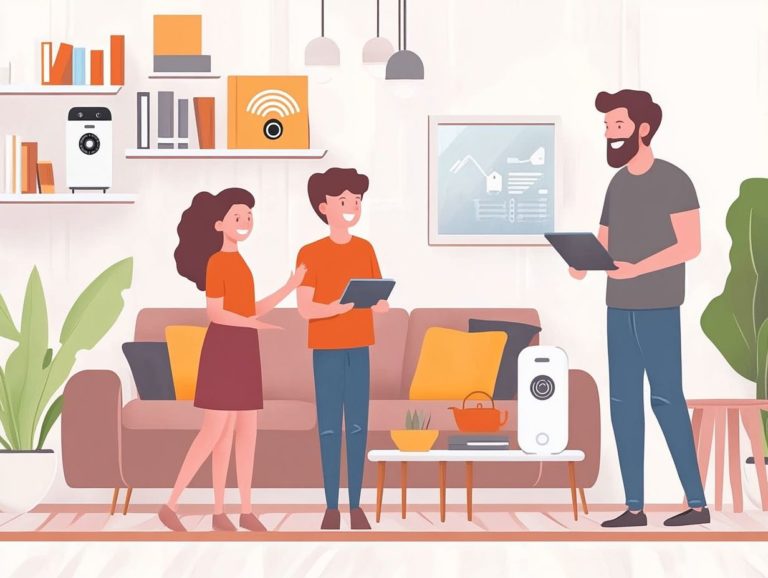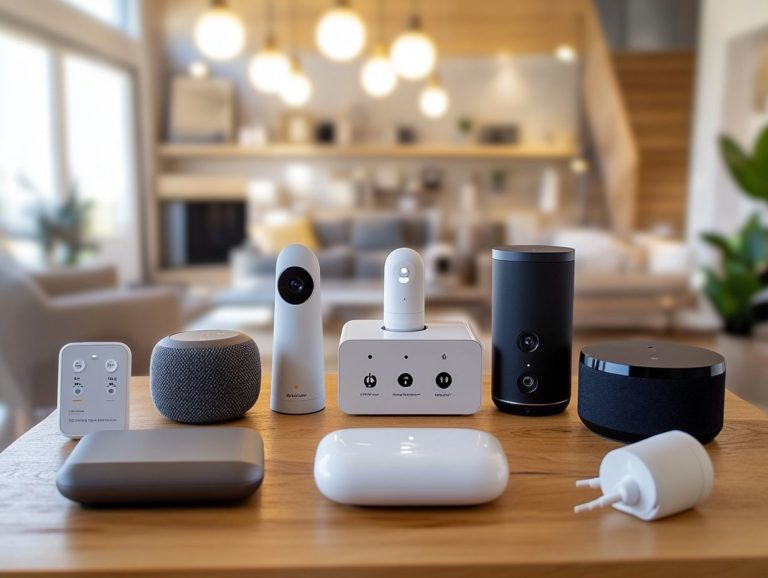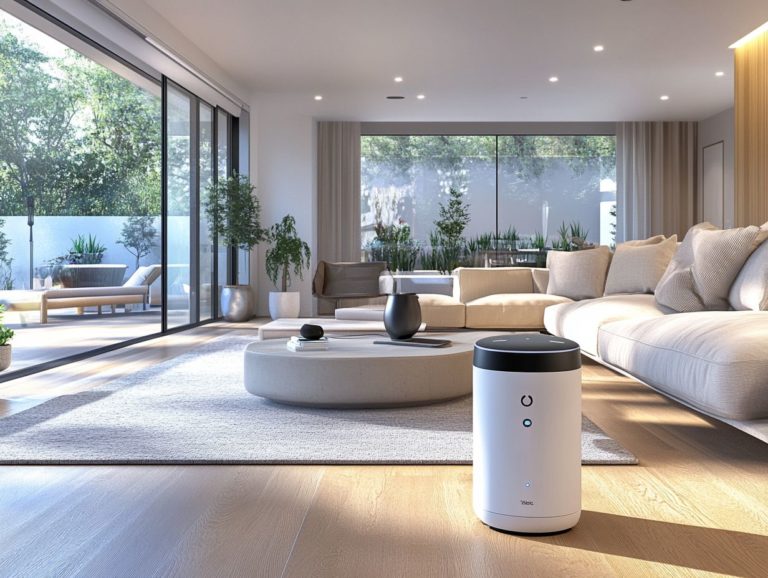How to Secure Your Smart Home Network
In today s digital landscape, your home is evolving into a smarter haven, but with that convenience come potential risks. As you connect more devices to your network, it becomes vital to understand the vulnerabilities that could jeopardize your personal information.
This article delves into the importance of securing your smart home network, highlights common weak points, and offers actionable steps to enhance your security. From establishing strong passwords to adopting advanced measures like network segmentation, you ll be guided in crafting a fortress around your connected devices. Embark on this journey with us as we uncover essential practices to ensure your smart home remains a safe sanctuary.
Contents
- Key Takeaways:
- The Importance of Securing Your Smart Home Network
- Assessing Your Current Network Security
- Steps to Secure Your Smart Home Network
- Additional Measures for Enhanced Security
- Frequently Asked Questions
- What is a smart home network?
- Why is it important to secure your smart home network?
- How can I secure my smart home network?
- What are some common vulnerabilities in smart home networks?
- Are there any additional security measures I can take for my smart home network?
- What should I do if I suspect my smart home network has been compromised?
Key Takeaways:
- Secure your smart home by protecting your network.
- Identify weak points in your network security.
- Enable two-factor authentication and use strong passwords.
- Keep firmware and software updated for added security.
- Use encryption to safeguard your data.

The Importance of Securing Your Smart Home Network
In today’s fast-evolving technological landscape, securing your smart home network is paramount. As smart devices and home automation systems become more integrated, the risk of online threats and data breaches escalates, putting both user and digital privacy at considerable risk.
With millions of connected devices communicating across the Internet of Things (IoT), it’s essential to grasp the significance of robust IoT security and implement effective measures. By doing so, you can safeguard the integrity of your home network and enjoy peace of mind in an increasingly interconnected world.
Potential Risks and Vulnerabilities
Smart devices undoubtedly enhance your convenience and efficiency, but they also introduce significant online threats that can lead to unauthorized access to your personal data and privacy violations. These vulnerabilities arise from several factors, such as outdated software that fails to patch known security flaws, making them ripe for exploitation by malicious actors.
Many users often overlook the importance of creating unique passwords and instead opt for generic ones that can be easily hacked. Data miners further jeopardize your privacy by collecting sensitive information without your consent. As a result, these weaknesses not only place your data at risk but also raise serious concerns about the integrity of IoT security as a whole.
Assessing Your Current Network Security
Start by checking your home network security it s the first step to keeping your smart home safe! Identify any vulnerabilities that could leave you susceptible to online threats and potential breaches. This proactive approach will ensure your home remains a secure haven in an increasingly connected world.
Identifying Weak Points and Vulnerabilities
Identifying weak points and vulnerabilities within your home network is essential for fortifying your smart home technology against potential online risks. By systematically evaluating the various components of your network, you can gain a clearer insight into how cyber attackers might gain unauthorized access.
For example, many smart devices, like thermostats and cameras, often come equipped with weak, default passwords that can be easily exploited if not changed. Outdated software can act as open invitations for malicious attacks. Conduct thorough scans of your network for connected devices, use penetration testing tools, and regularly update your security protocols to uncover these vulnerabilities.
It s imperative to adopt a proactive approach to risk management, ensuring that your devices and networks are sufficiently resilient against emerging threats.
Steps to Secure Your Smart Home Network

Securing your smart home network involves a thoughtful approach. Implement effective security measures, including setting unique passwords, performing regular software updates, and enabling two-factor authentication.
Taking these deliberate steps will significantly enhance the integrity of your home network. Start securing your smart home today don t wait for a breach to take action!
Setting Up a Strong Password
Setting up a strong password is crucial for safeguarding your smart home security. It significantly boosts data protection against unauthorized access.
A strong password should have at least 12 characters. Incorporate a mix of upper and lower case letters, numbers, and special symbols to enhance its complexity.
Avoid easily guessable words or sequences. Instead, choose unique combinations that are harder to crack. Create distinct passwords for different devices to ensure that a single breach doesn t jeopardize multiple items.
Changing default passwords in your smart home technology is important. Factory settings are often common knowledge and can serve as easy entry points for intruders. Customizing your passwords lays a solid foundation for your home s security.
Enabling Two-Factor Authentication
Enabling two-factor authentication (2FA) is a smart move to reduce cybersecurity risks. It adds an extra layer of protection for your smart home security.
By requiring a second form of verification, such as a text message code or an authentication app, you can significantly lower the chances of unauthorized access. This is especially important with smart devices that often store sensitive information, from security cameras to smart locks.
The benefits of using 2FA are numerous: you gain better privacy, improved control over device access, and increased peace of mind.
To set up 2FA on your devices, go to the settings menu of each one. Find the security options and follow the prompts to activate and link your secondary authentication method whether it’s a phone number or an authenticator app.
Updating Firmware and Software
Regularly updating your firmware and software is essential for keeping your smart home technology secure. It protects you from evolving cybersecurity threats.
These updates not only fix vulnerabilities but also improve the functionality of your devices. This ensures that everything in your connected ecosystem operates smoothly and reliably.
If you’re managing a smart home, keeping up with firmware updates might feel overwhelming. However, it s vital for protecting your personal information.
To check for updates, navigate to the settings section of your devices or apps, where you ll often find notifications about available updates.
Many smart home devices offer automated updates. Enabling these settings allows your system to stay secure without needing constant manual checks. This gives you peace of mind while enjoying the convenience of smart technology.
Using Encryption
Using encryption is crucial for protecting your data. It ensures that the information transmitted between your smart home devices stays secure from prying eyes.
Encryption converts readable data into a coded format that only authorized users can decipher. This makes it nearly impossible for cybercriminals to access sensitive information.
It s not just about protecting personal data; it also safeguards the operational integrity of your smart devices, like security cameras and thermostats.
Several methods of encryption are available, including:
- AES (Advanced Encryption Standard)
- RSA (Rivest-Shamir-Adleman)
- TLS (Transport Layer Security)
Each method protects different information types, ensuring your data stays safe. Employing strong encryption methods is essential for anyone looking to enhance their smart home security and maintain their privacy.
Additional Measures for Enhanced Security

To elevate your smart home security, consider implementing advanced strategies like network segmentation and creating a strong smart mesh network.
Conduct regular scans to identify any vulnerabilities. Taking these steps will significantly bolster your defenses and provide you with peace of mind.
Don’t wait start securing your home today and enjoy peace of mind!
Network Segmentation
Network segmentation is a powerful strategy to enhance your smart home security. By isolating various devices within your home network, you can reduce the attack surface for potential threats.
Organizing your devices into separate sub-networks allows for better control over access and monitoring of traffic flow. This customized approach creates distinct zones where different types of devices communicate only with essential components, minimizing the risk of a compromised smart appliance affecting your core systems.
Implementing segmentation also allows for efficient management of security protocols, ensuring your sensitive information remains well-protected.
To achieve this, consider practical steps such as:
- Setting up your router to create separate networks for different devices
- Using firewalls to establish strict access controls between segments
It’s wise to assess your devices and prioritize segments based on risk levels.
Regular Network Scans and Audits
Regular network scans and audits are crucial for maintaining your smart home security. This proactive approach helps you detect and address cybersecurity risks before they become serious issues.
By using specialized tools, you can easily assess your network s integrity. These tools range from simple applications that ping devices on the network to advanced software capable of conducting comprehensive vulnerability assessments.
Scanning allows you to identify unrecognized devices, outdated firmware, and potential entry points for cyber threats. Regular audits reveal vulnerabilities and strengthen your overall security posture, giving you peace of mind that your smart home technologies are protected against attacks.
Make these scans a regular habit! You’ll boost your smart home s security and enjoy peace of mind.
Frequently Asked Questions
What is a smart home network?
A smart home network connects all your smart devices, such as lights, thermostats, and security cameras, to a single network. This allows you to control them remotely through a smartphone or voice commands.
Why is it important to secure your smart home network?

Securing your smart home network is crucial for protecting your personal information and preventing unauthorized access to your devices. Without proper measures, hackers could control your devices and gain access to your home’s Wi-Fi network.
How can I secure my smart home network?
To secure your smart home network, take steps such as:
- Using strong and unique passwords for each device
- Regularly updating your devices’ firmware
- Setting up a firewall to block unauthorized access
What are some common vulnerabilities in smart home networks?
Common vulnerabilities include weak or default passwords, outdated firmware, and improperly configured or secured devices. Using unsecured Wi-Fi networks also makes your network vulnerable to attacks.
Are there any additional security measures I can take for my smart home network?
Yes! You can enable two-factor authentication for your devices, use a virtual private network (VPN) when accessing your network remotely, and limit access by only allowing trusted devices to connect.
What should I do if I suspect my smart home network has been compromised?
If you suspect a compromise, immediately disconnect all devices from the network and change all passwords. Run a security scan on each device and contact the manufacturer for further assistance. You may also need to reset your network to ensure all vulnerabilities have been addressed.
In conclusion, securing your smart home is essential. Start taking action today it only takes a few minutes!






